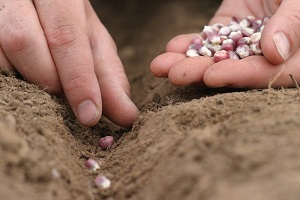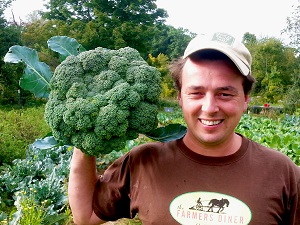Dan Kittredge is no stranger to original thinking. Nothing is beyond scrutiny and he isn’t afraid to redefine success. In many ways, he’s defied the status quo throughout his life and throughout his time as founder and Executive Director of the Bionutrient Food Association.
Kittredge was raised on an organic farm and, from a young age, became well-versed in the movement to grow and consume crops in healthy ways. Unlike many kids, he learned just how harmful the processed foods found on supermarket shelves could be. Unlike many kids, he learned that the nutrition levels of plants – even organic ones – were “embarrassingly low.” And unlike many kids, he decided to do something about it.
 Already a lifelong farmer, Kittredge began to work with the nonprofit Remineralize the Earth, an organization that promotes soil health, nutritious foods and the fight to end climate change through the use of natural minerals. Remineralize the Earth launched a project titled the Real Food Campaign in 2008, and in 2010, as an outgrowth from that campaign, Kittredge founded the Bionutrient Food Association.
Already a lifelong farmer, Kittredge began to work with the nonprofit Remineralize the Earth, an organization that promotes soil health, nutritious foods and the fight to end climate change through the use of natural minerals. Remineralize the Earth launched a project titled the Real Food Campaign in 2008, and in 2010, as an outgrowth from that campaign, Kittredge founded the Bionutrient Food Association.
Bionutrient began with a simple mission statement: to increase quality in the food supply. This was intentional, Kittredge said, because the work will never be complete.
“It’s broad enough to give us the freedom to prioritize what seems the most strategic,” Kittredge said.
In Bionutrient’s first few years, it prioritized education for interested farmers. The nonprofit conducted courses where farmers learned techniques to improve the health of their soil and crops. In turn, farmers often saw larger yields, more nutritious foods and an uptick in business. Bionutrient coined the term ‘nutrient density’ to refer to how nutritious a particular food is. ‘Nutrient density’ can be seen on a few packages around the country and even has its own Wikipedia page.
Bionutrient has expanded steadily in its eight years of existence, in both influence and paying members. The educational programs have followed suit. The organization’s website houses an extensive library of informational materials, including recommended reading lists and instructional video clips of Kittredge’s teachings. There are even downloadable audio recordings from the annual Soil & Nutrition Conference that Bionutrient co-sponsors. Kittredge travels regularly to speak at conferences and workshops, all while tending his own farm.
Last year, Kittredge said, was Bionutrient’s best yet. People around the United States have bought into Bionutrient, evidenced by its 12 volunteer-led local chapters. Kittredge plans to further develop his presence in Canada and Mexico and eventually the rest of the globe. Remarkably, Bionutrient has grown via word-of-mouth, not formal advertising or fundraising campaigns.
 “Doing good work foundationally,” said Kittredge, “doing powerful, meaningful, significant work is the kind of thing that is going to not only bring fulfillment but also support.”
“Doing good work foundationally,” said Kittredge, “doing powerful, meaningful, significant work is the kind of thing that is going to not only bring fulfillment but also support.”
Kittredge has seen other nonprofits become engulfed by marketing and grant-writing pressures to the detriment of the positive change they worked to accomplish. Under Kittredge’s leadership, that will never happen to Bionutrient.
“If what we’re doing is valuable enough, people will want to support us on their own volition,” Kittredge said.
With the increase in funds Bionutrient has acquired, more is now available to put toward research initiatives. The major research project now underway is the Bionutrient Meter. Kittredge’s vision for the Bionutrient Meter is to be able to capture the nutritional value of foods in a grocery store via a flash of light. As consumer-friendly as a phone app.
“It helps to bring consumers past the marketing and labeling to the question of: ‘how good is this food for me or my children?’” Kittredge said.
As incomprehensible as it sounds, Kittredge and his team are close to making it a reality. He said he expects a consumer-calibrated Bionutrient Meter to be available by the end of next year, and one available commercially in five years. As you read this, universities are testing 60-70 prototypes of the meter’s first iteration.
 The excitement surrounding the work of the Bionutrient Food Association hasn’t gone unnoticed. And that’s all part of Kittredge’s plan. He said major players in the field have begun to inquire about Bionutrient’s innovative solutions.
The excitement surrounding the work of the Bionutrient Food Association hasn’t gone unnoticed. And that’s all part of Kittredge’s plan. He said major players in the field have begun to inquire about Bionutrient’s innovative solutions.
Historically, other nonprofits have gained momentum by identifying an enemy and combating it. Bionutrient could do the same, but that’s not Kittredge’s style. He doesn’t want to have that conversation. Instead, he thrives through collaboration.
“We’re not going to complain about anybody or fight somebody,” Kittredge said. “Our conviction is not to fight conventional (agriculture) but to help conventional (agriculture) do a better job. We want to help organic farmers do a better job. We want to help nutritionists do a better job.”
Kittredge’s unique vision is to work together with opposing forces to make the world a better place. By doing the foundational work, those competing organizations will recognize the value of Bionutrient’s philosophy and be incentivized to change their ways.
Kittredge refuses to let his nonprofit be defined as only a part of the Real Food Movement. By using Bionutrient’s innovative farming techniques, Kittredge said, human health outcomes can improve and climate change can reverse. In fact, synergizing these movements is what he’s most excited about.
“We can really be part of saving the world in some meaningful way,” Kittredge said in his ever-optimistic manner.
Some may say it’s impossible. But it was also impossible to raise money without asking for it, or spread your brand without marketing, or succeed in business while trying to collaborate with the opposition. Kittredge has done those already. Sometimes, all you need is an altruistic calling and a non-conformist attitude to accomplish impressive things in the nonprofit world.
Kevin Mercer is a recent graduate of the UNC School of Media and Journalism with an interest in working to help people in the nonprofit industry. He loves history and all things sports-related.






